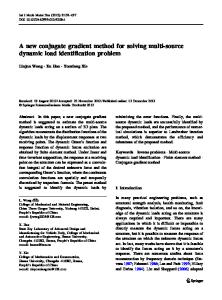Identification of Multi-Point Dynamic Load Positions Based on Filter Coefficient Method
- PDF / 1,844,827 Bytes
- 11 Pages / 595.276 x 790.866 pts Page_size
- 50 Downloads / 283 Views
ORIGINAL PAPER
Identification of Multi‑Point Dynamic Load Positions Based on Filter Coefficient Method Jing Zhang1 · Fang Zhang1 · Jinhui Jiang1 Received: 14 June 2020 / Revised: 3 September 2020 / Accepted: 4 September 2020 © Krishtel eMaging Solutions Private Limited 2020
Abstract Background Dynamic load identification plays an important role in practical engineering. In this paper, a novel fast algorithm is investigated to identify the multi-point dynamic load positions in frequency domain. Methods For any given frequency, the amplitude of each load spectrum is relatively constant. By solving the kinetic equation set with the elimination method, the relationship of the true dynamic load positions can be expressed as the form of filter coefficients, then many dynamic load position combinations can be found that they do not satisfy the relationship so they can be excluded from the possible true position combinations. Compared to the traditional method, the novel algorithm only needs to sort out the true positions from a few dynamic load position combinations by the minimum determination coefficient method, which reduces the number of matrix inversion operations and improves the speed of the identification of load positions. Conclusions Through a numerical simulation and an identification test on the simply supported beam structure, the high accuracy and effectiveness of the novel algorithm are successfully demonstrated, while the rapidity of the novel algorithm is shown by comparing the computation time of the novel algorithm with that of the traditional method. Keywords Load position identification · Frequency domain · Determination coefficient method · Filter coefficient · Inverse problem
Introduction Contemporarily, the identification of dynamic load and its position plays a crucial role in substantial practical engineering situations including motion of vehicle or aircraft and vibration of buildings induced by earthquake, wind or waves. There are two approaches used to identify dynamic loads: the direct way and indirect way. The direct method determines the dynamic loads by measuring apparatus, however, the dynamic loads are difficult to measure directly or even cannot be measured in many complex practical engineering situations, including push force acted on the rocket, road excitation applied to vehicle, etc. Thus, the technique of load identification, a significant indirect way to obtain dynamic loads, has been rapidly developing since the early 70s. It * Fang Zhang [email protected] 1
State Key Laboratory of Mechanics and Control of Mechanical Structures, Nanjing University of Aeronautics and Astronautics, Nanjing, China
determines dynamic loads based on the dynamic characteristics of system and the measured responses of structure. Currently, there are two main series of load identification method: the frequency-domain technique and the timedomain technique. The frequency-domain technique converts the kinetic equation into frequency domain to identify the loads with known information. Due t
Data Loading...











